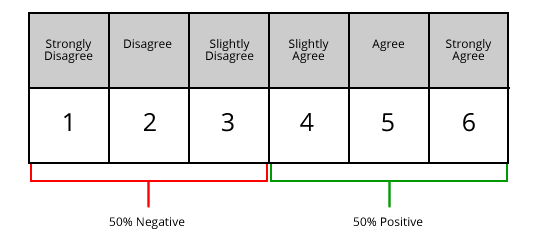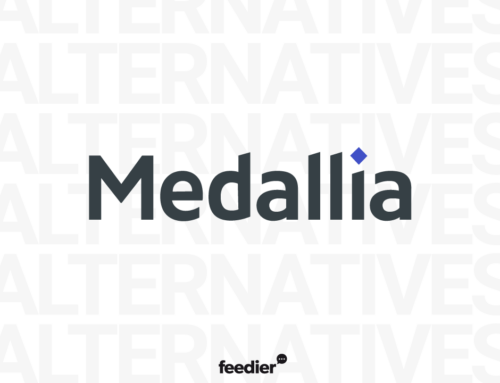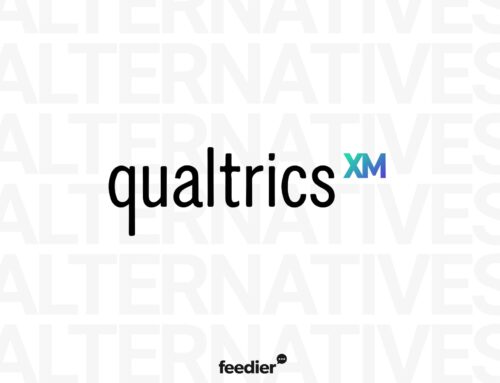What are you talking about? The Likert Scale survey question? Sounds like a blurry concept, doesn’t it?
I know that feeling. In this article, I’m going to peel it off for you, explain you the ins-and-outs of the Likert scale, and how you can apply it in your next survey.
What Is The Likert Scale
The Likert Scale is a rating scale that’s often used when surveying your customers regarding their experiences with your company.
It can be used to measure anything from the service they were provided to the overall effectiveness of your product.
It’s one of the most popular question types with the Net Promoter Score when collecting feedback.
The Likert scale is a series of questions or items that ask your customers to select a rating on a scale that ranges from one extreme to another, such as “strongly agree” to “strongly disagree.”
Unlike binary “yes or no” questions, the Likert scale gives you deeper insight into what your customers are thinking and how they feel.
(Note: Need a way to create a survey with Likert Scale questions so you can research your potential market or existing customers? Feedier can help.)
When To Use The Likert Scale
The Likert Scale is best used to measure and evaluate customer sentiment on a specific product, service or experience.
Likert items that center around the same topic should be grouped together in your survey, creating what’s called a “single-topic” Likert scale.
The scale itself, regardless of whether it uses numeric or text labels, should be consistent on each item; this prevents confusion for your customers and simplifies the analysis of their answers for you.
You want them to follow a pattern and avoid any inconsistency.
In my experience, the best Likert scale surveys include open-ended questions after the Likert question, segmented based on the answer to you can learn more about the choice.
Likert Scale “Points”
There is no proper requirements when it comes to choosing number of choices, or “points” a Likert question should contain.
As a rule of thumb, it’s best to be extensive and provide a sufficient number of options for your respondents to provide an accurate response – but not so many that they become overwhelmed.
5-Point Likert Scale
The first and most famous option is to go with a 5 point Likert scale questionnaire.

7 Point Likert Scale
If you want to be more exhaustive, and accurate, the 7-point Likert scale would be your go-to. But keep in mind that it can be very distracting and less comprehensive for the respondent.

But there’s a more subtle difference between 5-point and 7-point Likert scales.
Notice that, in the 5-point example, the most negative response translates to the customer saying there is a 0% chance of them recommending the product. But, that doesn’t necessarily mean they’ll recommend against using the product. In other words, the extremely negative response isn’t a polar opposite of the extreme positive response; it’s simply a null set.
On the other hand, the 7-point Likert scale question does deal with polar opposites.
Rather than the extreme negative response translating to “nil,” as in the 5-point scale question, the central response represents “no satisfaction.” The extreme negative response, then, represents the opposite of the extreme positive: not only is a person who responds this way not satisfied by the service, but they’re entirely dissatisfied with it.
4 Point Likert Scale – Odd & Even Points
Likert scale questions can provide either an odd or even number of response options.
Neither way is necessarily “better” than the other: it simply has to do with your preferences and purposes.
An odd number of choices, as illustrated above, allows respondents to report neutrality.
On the one hand, there’s a chance that some customers might simply use the “neutral” choice as a way to skip the question altogether – meaning they don’t provide any valuable information regarding the question at hand.
On the other hand, neutral responses can prove to be valuable, in that they translate to the fact that your service didn’t do enough to lead your customer to have an opinion on the topic at hand.
By providing an even number of choices, you don’t allow for neutrality.

Respondents must choose a positive or negative answer. While this might lead customers who were “on the fence” to think a little deeper about a certain question, some might simply skip the question altogether.
There’s also the very real possibility that a customer truly doesn’t have an opinion regarding a certain question. If these individuals are forced to choose a side, their response could skew the overall results of the survey.
In either case, there’s a possibility of your customers responding ambiguously.
In these cases, your best bet may be to provide room for your customers to expand on their answers in order to avoid discrepancies and unusable data.
Likert Scale Examples
A Likert Scale can be used in just about any situation where you are looking to use a rating scale to get insights into your customer behaviors and feelings however the most common Likert Scale examples include the following use cases:
- Agreement
- Likelihood
- Satisfaction
- Importance
Let’s take a look at each in a bit greater detail.
1. Agreement
Question:
“The checkout process was straightforward”
Answers:
- Strongly Agree
- Agree
- Neither Agree Nor Disagree
- Disagree
- Strongly Disagree
An agreement scale is the most common use case for a Likert Scale. Using this format, your customers would be provided with a series of statements, for which they select Strongly Agree, Agree, Neither Agree Nor Disagree (or Neutral), Disagree or Strongly Disagree.
2. Likelihood
Question:
“I would recommend this product to my friends”
Answers:
- Very Likely
- Likely
- Neutral
- Not Likely
- Very Unlikely
The likelihood version of a Likert scale is most often used to determine the probability that your customers will adopt a particular behavior, whether that behavior is buying a product or recommending a service to others.
3. Satisfaction
Question:
“Please rate your satisfaction with your recent customer service experience:”
Answers:
- Very Happy
- Somewhat Happy
- Neutral
- Not Very Happy
- Not at All Happy
This common Likert scale measures how satisfied each customer is with a particular experience, product or service. As with the example above, the satisfaction-based question is most often used to get an opinion from customers about your service or support.
4. Importance
Question:
“Rank each item in reference to its importance to you:”
Answers:
- Very Important, Important
- Moderately Important
- Slightly Important
- Not Important
The importance scale provides deeper insight into the reasons behind more general opinions.
It shows how strongly your customers rank the influence of various factors for an experience, product or service.
Likert Scale Analysis
Though analysis of Likert scale data can be quite the scientific and mathematical undertaking (especially in determining validity, distortions, etc.), in this section we’ll discuss a simple way in which to interpret the data you’ve collected, which is determining the percentage of your customers that respond a certain way to each individual question.
Most commonly, Likert scales are evaluated by giving each option a value and then adding these values together to create a score for every customer.
Though relatively simple, this reporting method makes it easy to evaluate the opinions revealed by each Likert option. A chart of scores can offer visual insight into sentiment on a particular Likert scale.

By doing this for each question, you’ll be able to determine areas in need of improvement, as well as areas in which your company is thriving.
You also might notice areas of concern where you initially might have thought things were running smoothly.
The most important factors in reporting on the Likert scale are consistency in values and cohesiveness in questions or items that are evaluated together. Questions that are out of place can skew the results, making it harder to take the right actions based on the answers your customers give you.
Speaking of skewed results…
Possible Survey Distortions
Going along with the last notion, the answers your customers provide when completing satisfaction surveys might not always be entirely accurate.
Simply put: human nature sometimes gets in the way of customers responding openly and honestly.
The most efficient way to combat these distortions is to always give your respondents the option of providing more detail – or discussing confusion – regarding a specific question or set of questions.
However, it’s still important to understand the possible biases your customers come to the table with in order to identify possible distortions or discrepancies among your data. The biases you’re most likely to encounter are:
Central Tendency Bias
As the name implies, central tendency bias refers to the notion that some respondents may avoid choosing the most extreme options provided.
The most common explanation for this tendency is that respondents don’t have a clear definition of the extreme high or extreme low with regard to a specific question.
For example, when responding to the question “How would you rate our company’s customer service?” (with responses ranging from “Unhelpful” to “Extremely helpful”), a customer who did receive exemplary customer service might get caught up in the semantics of what “extreme” actually means. It’s possible that, although they acknowledge the service was exquisite, they are hesitant to report that it was the be-all-end-all of customer service.
Another explanation for central tendency bias is that customers might initially “save up” their “extreme” answers for later questions. If they answer the first question with an “extreme” answer, they might view the rest of their answers through the lens of this first answer. (i.e., to respond with an “extreme” answer to subsequent questions, their level of satisfaction will have to match the level of satisfaction regarding that first question).
In addition to providing opportunities for respondents to expand on their answers, you can also avoid falling victim to central tendency bias by either providing context for what certain terms (such as “excellent”) mean, or allowing respondents to define the terms in their own words.
Extreme Response Bias
In contrast to central tendency bias, extreme response bias is the tendency for some respondents to only answer in extremes.
There are, again, a number of reasons this might occur, including:
- Cultural attitudes
- The intelligence level of respondents
- Level of effort respondents put into completing a survey
- The way in which questions and choices are worded
Of these four reasons, the only one you truly have control over is the last one. Ensure the questions you ask don’t lead respondents toward a certain answer, and also that each option is clearly defined and understandable.
You can address the issues of cultural and intellectual diversity by soliciting demographic and other personal information from each respondent. While not an absolute determinant by any stretch, it’s possibly the closest you can get to figure out why a respondent answered as they did (short of asking them, of course).
Acquiescence Bias
Acquiescence bias refers to a respondent’s tendency to go along with a statement in an effort to avoid ruffling feathers or insulting anyone.
For example, say a customer received subpar service from an employee who truly did their best to meet the customer’s needs. Though the customer didn’t end up with the result they desired, they might report they received “excellent” customer service from said employee simply because they tried to be helpful. But, for the purposes of the survey, such a response isn’t helpful at all.
To avoid such a discrepancy, ask clear and specific questions throughout your survey. Using the above example, if the customer was asked about the employee’s willingness to help (in addition to being asked about the service they received), they would have a chance to show that the employee tried to help, but ultimately wasn’t able to.
Another way to possibly avoid acquiescence bias is to make clear to respondents that the purpose of the survey in the first place is to improve customer service across the board. Though there will certainly still be cases of such bias, this simple disclaimer might open the door for more honesty from many of your customers.
Creating a Likert Scale With Feedier
If you need a way to create a survey that includes a Likert Scale, you can do so with Feedier. Here’s the process.
To create a Likert Scale question with Feedier, you first want to sign in to your account (or sign up free if you don’t have an account).
We want to use the Choice question, which looks like this:

Then add your points, or options.
Wrapping Up
Likert scale questionnaires can help you gain valuable insight regarding your customers’ experience and levels of satisfaction with different aspects of your company.
In turn, you’ll be able to improve areas in which you fall short of your customers’ expectations – and strengthen the areas in which you’re already doing quite well.






